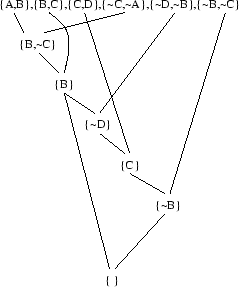Prenex form:
![]() .
.
Skolemized form:
![]() .
.
Without universal quantifiers:
![]() .
.
Adequate connectives:
![]() .
.
Conjunctive normal form (or clausal form):
![]() .
.
Prenex form:
![]() .
.
Skolemized form:
![]() .
.
Without universal quantifiers:
![]() .
.
Adequate connectives:
![]() .
.
Truth table:
| T | T | F | F | T |
| F | T | T | T | F |
| T | F | F | F | T |
| T | F | F | T | F |
Disjonctive normal form:
![]() .
.
De Morgan's law yiels a conjunctive normal form (or clausal form):
![]() .
.
We use the following resolution rule:
where ![]() is a clause and
is a clause and ![]() a literal. The wffs are considered
to be written in CNF using the standard set notation.
a literal. The wffs are considered
to be written in CNF using the standard set notation. ![]() is
refered to as a parent clause and
is
refered to as a parent clause and
![]() is refered to as
the resolvent.
is refered to as
the resolvent.
In a linear resolution, we follow the standard resolution procedure but we take care of the fact that the previous resolvent is always a parent clause of the next resolution.

We yield the empty clause, that means that we set of clauses is not satisfiable, i.e., there is no interpretation thanks to which this set can be given a true value.